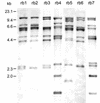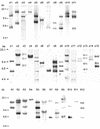Molecular epidemiology of Vibrio cholerae O139 in China: polymorphism of ribotypes and CTX elements
- PMID: 12791841
- PMCID: PMC156495
- DOI: 10.1128/JCM.41.6.2306-2310.2003
Molecular epidemiology of Vibrio cholerae O139 in China: polymorphism of ribotypes and CTX elements
Abstract
Vibrio cholerae O139, the second etiological serogroup of cholera, triggered the first outbreak of O139 cholera in China in 1993. To analyze the clone polymorphism of O139 isolates in China, 117 strains of V. cholerae O139, isolated from different areas in China between 1993 and 1999, were selected to characterize the phylogenetic relationships by molecular techniques. Analysis of restriction fragment length polymorphism in the conserved 16S rRNA gene revealed seven different ribotypes within the 117 strains. Among these strains, there were eight that lacked the cholera toxin gene (ctxAB), zot, and the repetitive sequence (RS); these eight strains belonged to three individual ribotypes. Our results suggested that V. cholerae O139 strains in China had clone diversity in phylogeny. The results of our hybridization patterns for CTX genetic elements (ctxAB, zot, and RS) showed that CTXPhi genomes in most V. cholerae O139 strains had two or more copies and had extensive restriction patterns even for the strains which belong to the same ribotype. For 22 (20.1%) strains, the copies of ctxAB were different from those of zot, suggesting that a ctxAB-negative CTXPhi genome may exist in O139 strains. This ctxAB-negative CTXPhi genome may coexist with the intact CTXPhi genome in a strain. In addition, the dendrogram for I-CeuI-generated pulsed-field gel electrophoresis patterns showed that V. cholerae serogroup O139 has a closer relationship with one strain of serogroup O22 than with the strains of serogroup O1. The results of this study showed the clonal diversity and the distribution of O139 strains in China, suggesting multiple origins of the O139 cholera epidemic or sporadic events.
Figures



Similar articles
-
Molecular analysis of Vibrio cholerae O1, O139, non-O1, and non-O139 strains: clonal relationships between clinical and environmental isolates.Appl Environ Microbiol. 2001 Feb;67(2):910-21. doi: 10.1128/AEM.67.2.910-921.2001. Appl Environ Microbiol. 2001. PMID: 11157262 Free PMC article.
-
Molecular analysis of toxigenic Vibrio cholerae O139 Bengal strains isolated in Bangladesh between 1993 and 1996: evidence for emergence of a new clone of the Bengal vibrios.J Clin Microbiol. 1997 Sep;35(9):2299-306. doi: 10.1128/jcm.35.9.2299-2306.1997. J Clin Microbiol. 1997. PMID: 9276406 Free PMC article.
-
Molecular characterization of a new ribotype of Vibrio cholerae O139 Bengal associated with an outbreak of cholera in Bangladesh.J Clin Microbiol. 1999 May;37(5):1313-8. doi: 10.1128/JCM.37.5.1313-1318.1999. J Clin Microbiol. 1999. PMID: 10203477 Free PMC article.
-
Emergence of a new cholera pandemic: molecular analysis of virulence determinants in Vibrio cholerae O139 and development of a live vaccine prototype.J Infect Dis. 1994 Aug;170(2):278-83. doi: 10.1093/infdis/170.2.278. J Infect Dis. 1994. PMID: 8035010 Review.
-
Non-serogroup O1/O139 agglutinable Vibrio cholerae: a phylogenetically and genealogically neglected yet emerging potential pathogen of clinical relevance.Arch Microbiol. 2022 May 14;204(6):323. doi: 10.1007/s00203-022-02866-1. Arch Microbiol. 2022. PMID: 35567650 Free PMC article. Review.
Cited by
-
Phenotypic and Genetic Heterogeneity in Vibrio cholerae O139 Isolated from Cholera Cases in Delhi, India during 2001-2006.Front Microbiol. 2016 Aug 9;7:1250. doi: 10.3389/fmicb.2016.01250. eCollection 2016. Front Microbiol. 2016. PMID: 27555841 Free PMC article.
-
Characters of homogentisate oxygenase gene mutation and high clonality of the natural pigment-producing Vibrio cholerae strains.BMC Microbiol. 2011 May 18;11:109. doi: 10.1186/1471-2180-11-109. BMC Microbiol. 2011. PMID: 21592381 Free PMC article.
-
Multiple antibiotic resistance of Vibrio cholerae serogroup O139 in China from 1993 to 2009.PLoS One. 2012;7(6):e38633. doi: 10.1371/journal.pone.0038633. Epub 2012 Jun 11. PLoS One. 2012. PMID: 22701685 Free PMC article.
-
Quinolone Resistance Genes and Their Contribution to Resistance in Vibrio cholerae Serogroup O139.Antibiotics (Basel). 2023 Feb 20;12(2):416. doi: 10.3390/antibiotics12020416. Antibiotics (Basel). 2023. PMID: 36830326 Free PMC article.
-
Landscape of emerging and re-emerging infectious diseases in China: impact of ecology, climate, and behavior.Front Med. 2018 Feb;12(1):3-22. doi: 10.1007/s11684-017-0605-9. Epub 2018 Jan 24. Front Med. 2018. PMID: 29368266 Free PMC article. Review.
References
-
- Basu, A., A. K. Mukhopadhyay, C. Sharma, J. Jyot, N. Gupta, A. Ghosh, S. K. Bhattacharya, Y. Takeda, A. S. G. Farque, M. J. Albert, and G. B. Nair. 1998. Heterogeneity in the organization of the CTX genetic element in strains of Vibrio cholerae O139 Bengal isolated from Calcutta, India and Dhaka, Bangladesh and its possible link to the dissimilar incidence of O139 cholera in the two locales. Microb. Pathog. 24:175-183. - PubMed
-
- Bhadra, R. K., S. Roychoudhury, R. K. Banerjee, S. Kar, R. Majumdar, S. Sengupta, S. Chatterjee, G. Khetawat, and J. Das. 1995. Cholera toxin (CTX) genetic element in Vibrio cholerae O139. Microbiology 411:1977-1983. - PubMed
-
- Cholera Working Group, International Center for Diarrhoeal Disease Research, Bangladesh. 1993. Large epidemic of cholera like disease in Bangladesh caused by Vibrio cholerae O139 synonym Bengal. Lancet 342:387-390. - PubMed
Publication types
MeSH terms
Substances
LinkOut - more resources
Full Text Sources
Medical

